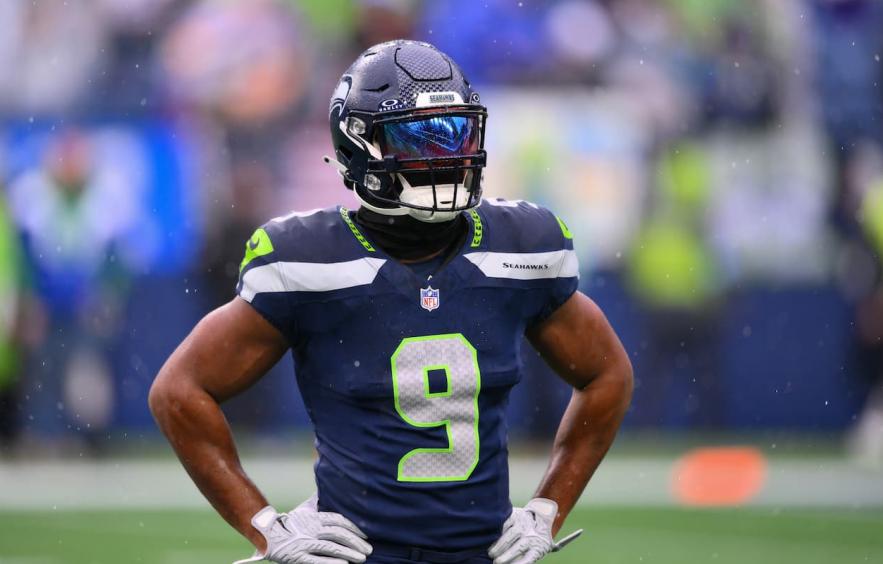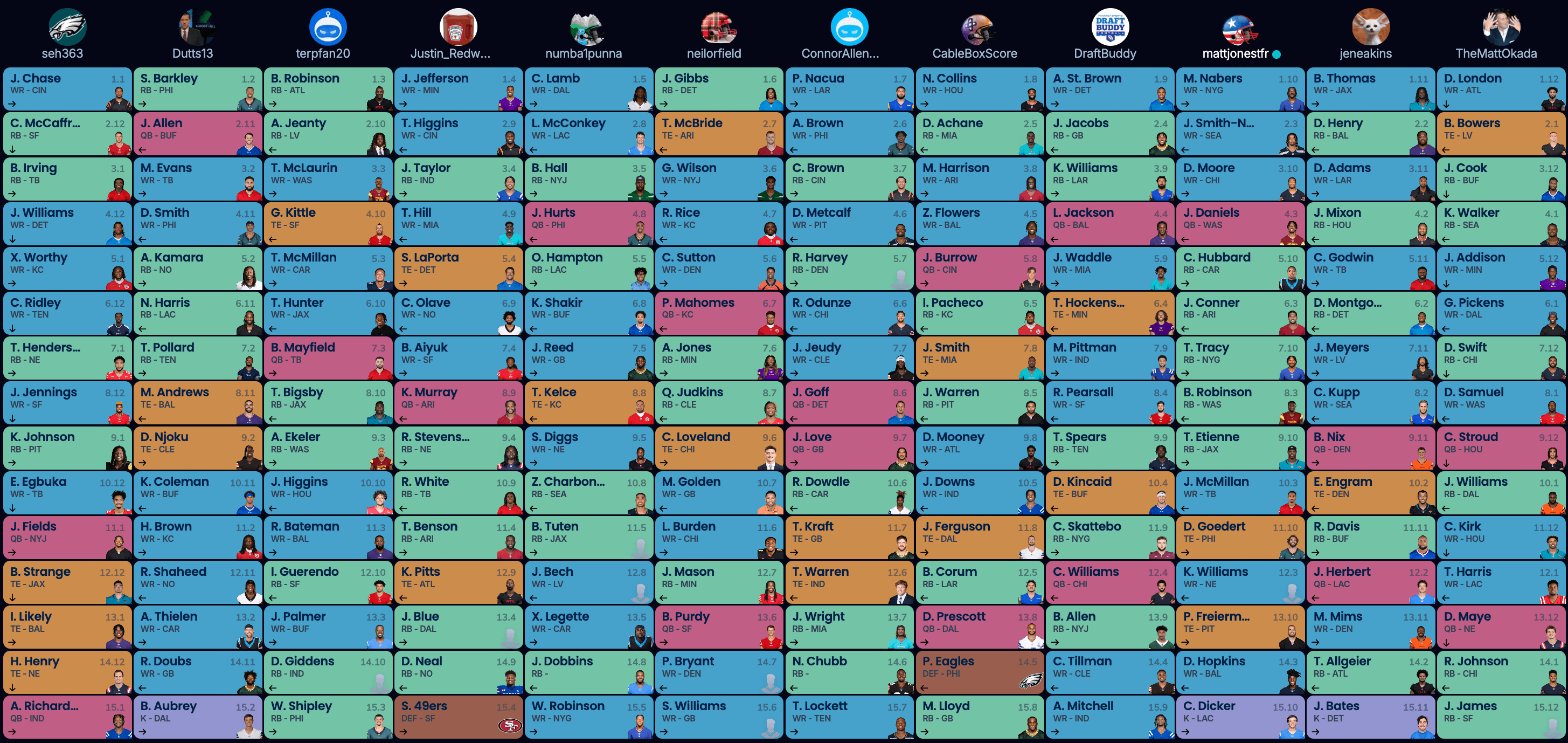Expert Fantasy Football Mock Draft Recap: 12-Team Half-PPR (May 2025)

At this point in the year, most fantasy football enthusiasts are at least starting to get the itch to hop back into drafts. If you're reading this, you may even have some drafts under your belt already. With voluntary OTAs starting around the league, I gathered 11 members of the 4for4 family to get an expert mock draft rolling.
The ADP referenced in this piece will be from our Underdog ADP tool. I'll post the whole draft board at the end.
2024 Fantasy Football Mock Draft Settings
- Roster Settings: 1QB, 2RB, 2WR, 1TE, 2 FLEX (RB/WR/TE), 7 BENCH
- Scoring: Half-PPR
Draft Participants in Order
1- Stephen Hoopes @seh363
2- Neil Dutton @Dutts13
3- Brendan Darr @terpfan20
4- Justin Edwards @Justin_Redwards
5- Jason Brown @numba1punna
6- Neil Orfield @neilorfield
7- Connor Allen @ConnorAllenNFL
8- Ryan Kirksey @CableBoxScore
9- Mike MacGregor @DraftBuddy
10- Matt Jones @Matt Jonestfr
11- Jennifer Eakins @jeneakins
12- Matt Okada @TheMattOkada
Rounds 1-3

Takeaways
Based on Underdog ADP, the first round is split up nearly in half, with seven wide receivers and five running backs being taken with the first dozen picks. We had to get to pick 16 for our RB5 to come off the board. You'll often find this in industry mock drafts, in my experience. In a league format where you can start four wide receivers, it's typically how things will go.
There were 14 running backs, 2 tight ends, and 20 wide receivers taken through the first three rounds.
Risers
The beginning of the first round went off as expected; the only players with second-round ADPs that went in our first round were Brian Thomas and Drake London.
The top two tight ends got pushed up a bit in this draft, as well. Brock Bowers and Trey McBride usually go with the 16th and 22nd picks, respectively. In our mock, they went 13th and 19th. In this part of the draft, a three-spot ADP jump is noteworthy as ADP is usually less volatile to start. After that, though, no other tight ends were taken in this section of the draft. That stands to reason, as there's no other TE with an ADP inside the Top 50 on Underdog right now.
Josh Jacobs saw a huge jump from his typical ADP. He was selected as the RB5 at 2.04. In most drafts, he's still available right around the 2/3 turn at about pick 24.
Fallers
Compared to ADP, the quarterbacks took a dive here. Josh Allen and Lamar Jackson are typically gone somewhere in this range, but fell to the fourth round in our mock. It's not surprising to see that happen as most of our drafters are savvy enough to load up on WRs and RBs early, knowing they can likely find QB production later on.
Rounds 4-6

Takeaways
At this point in the draft, roster construction and priorities start to take shape. Only two of our 12 drafters had filled out both onesie positions at this point in the draft. Three of our drafters have neglected those two positions entirely through the first six rounds.
As expected, the room skewed wide receiver-heavy. Ten of our 12 drafters had 3+ WRs at this point in the draft, while only two had three running backs. Three managers had a quarterback by the end of Round 6.
Risers
Kenneth Walker's selection at 4.01—21 spots ahead of his ADP—was one of the draft's biggest shocks. While Walker had been trending upward since drafts began, few expected him to land in the fourth round.
I spoke to Matt Okada, who made the selection about the pick. Here's what he had to say:
"I've spent most of this offseason hyping Kenneth Walker in dynasty, as he's the extremely talented lead back of an offense that heavily indexed towards the running game this offseason. With my placement at the turn — where ADP matters a little less — Walker and James Cook were my last shots at backs with legitimate RB1 upside."
This selection highlights a crucial late-draft principle: when facing long gaps between picks, securing targeted players often trumps strict ADP adherence. With 20+ picks separating selections in this range, managers must sometimes make moves that appear to be reaches. The alternative—waiting and hoping Walker returns several rounds later—carries significant risk.
This "reach early or lose them" mentality extended beyond running backs. Tight ends Sam LaPorta and T.J. Hockenson were both selected roughly 1.5 rounds ahead of their typical ADP, as managers with lengthy waits until their next picks prioritized locking in their TE1s over strict value adherence.
The pattern held across positions. Running backs Najee Harris, Isiah Pacheco, and Joe Mixon all went a full round above their standard ADPs, reflecting the same strategic calculus: in snake drafts with extended gaps between selections, perceived positional scarcity can justify significant ADP deviations.
The lesson for drafters is clear—late-round strategy requires balancing pure value against positional needs and draft timing. Sometimes the "reach" is actually the smart play.
Fallers
Heavy wide receiver selections in early rounds created a ripple effect that pushed quality receivers down draft boards. As drafters prioritized catching up at running back, several established wide receivers fell significantly past their average draft position. Travis Hunter dropped 27 spots, while Calvin Ridley, Tyreek Hill, and Rashee Rice each slipped more than a full round. Running backs, by contrast, held their value—Omarion Hampton's seven-spot drop was the largest at the position.
Rounds 7-12

Takeaways
The middle rounds revealed a clear shift in draft strategy, as managers began prioritizing depth and handcuff opportunities over strict adherence to ADP. Unlike the early rounds where wide receivers dominated, rounds 7-12 saw aggressive running back accumulation, with managers taking significant reaches on backup and situational backs.
Positional scarcity became a driving factor, particularly at tight end where managers jumped early on established veterans like Mark Andrews and David Njoku, both going 20+ picks ahead of ADP. The quarterback position saw extreme variance, with Sam Darnold representing the draft's biggest reach at 82+ picks early, while other QB options were completely ignored.
By round 12, roster construction patterns had fully emerged. Most managers had secured their starting lineups and were now focused on lottery tickets and handcuffs, leading to several high-upside rookies and situation-dependent veterans being selected well ahead of consensus.
Risers
The most notable trend was the aggressive targeting of backup running backs, with several going 25-60+ picks ahead of ADP. Tank Bigsby (64 picks early), Rico Dowdle (67 picks early), and Austin Ekeler (58 picks early) exemplified this strategy as managers prioritized handcuff and committee backs over consensus value.
Mark Andrews and David Njoku both went significantly early as managers sought stability at a volatile position. Andrews, in particular, was selected 20+ picks ahead of ADP as his draft capital reflected concerns about the position's lack of reliable options beyond the elite tier.
Sam Darnold's selection at pick 101—82 picks ahead of his 183.4 ADP—represented the draft's most extreme reach. This pick highlighted how some managers were willing to pay premium prices for perceived upside at quarterback rather than waiting for similar options later.
Fallers
In contrast to running backs being reached for, several proven wide receivers fell significantly below ADP. Deebo Samuel dropped 28 picks despite his established track record, likely due to injury concerns and San Francisco's crowded receiving corps. Matthew Golden fell 25+ picks from his ADP as managers showed more patience with unproven college prospects, preferring to secure known commodities at other positions before taking developmental flyers.
While backup RBs were being reached for, some established veterans fell. Kaleb Johnson dropped 21+ picks, suggesting managers were more willing to reach for specific handcuffs than take general depth pieces at ADP.
The middle rounds showcased the tension between value-based drafting and roster construction needs. Managers clearly prioritized securing specific player types—handcuff RBs, veteran TEs, streaming QBs—over strict ADP adherence, leading to significant reaches in some areas while creating value opportunities in others. Positional scarcity and specific roster needs trump consensus rankings at this point in the draft as drafters re-evaluate after the early rounds.
Rounds 13-15
 Takeaways
Takeaways
Rounds 13-15 represent fantasy football's complete philosophical shift from value-based drafting to pure scenario betting, where managers abandon traditional metrics for asymmetric risk/reward calculations. Every pick represents a specific "what if" scenario - practice squad promotions, veteran role changes, injury cascades - revealing sophisticated strategic thinking disguised as chaos. These aren't random dart throws but calculated bets on low-probability, high-impact events, where success depends not on avoiding bad picks but on correctly identifying which long-shot scenarios might materialize.
It's venture capital investing applied to fantasy football: accepting that 95% of these lottery tickets will fail in exchange for the 5% that could provide league-winning returns, all while understanding that bench spots carry zero opportunity cost. Fantasy managers anchor far too heavily on these later-round picks that will most likely just be churned through on the waiver wire.
At this point in the draft, ADP is so volatile that it's hard to say anyone was a real riser or faller. But there are a couple of picks that stood out as worthy of highlighting as late-round targets.
Isaiah Likely at the top of the 13th round seems like a very reasonable price for a guy who has his weekly upside. He's very clearly not just a plug-and-play starter every week, but there's enough smoke in the "maybe Mark Andrews has lost a step" fire to warrant the pick here. In Likely's 16 games played last year, he only dipped below 49% of the snaps in one game. I used that arbitrary cutoff because two games he had exactly 49%. Point being, he's on the field quite a bit, whether Andrews is in the lineup or not. Likely also totaled 14 red zone targets last year.
Romeo Doubs is an interesting swing here, as well. From a production standpoint, in his 24-year-old season, there are some good comps here. Tee Higgins, Christian Kirk, and Jerry Jeudy all had similar production in that year of their career (70-90 targets, 120-150 PPR Points) before breaking out for 200+ PPR Point seasons the following year.
Full Draft Board

Bottom Line
- Wide receiver selection dominated the early rounds, with 9+ WRs taken in Round 1 alone compared to only 3 RBs, showing an even more pronounced WR-heavy approach than last year's draft.
- Quarterback timing shifted earlier than expected, with a clear QB mini-run visible in Round 4 featuring multiple elite options.
- Tight end positional scarcity drove clustering behavior, with multiple TEs taken in Round 2 and TE runs throughout the middle rounds as managers prioritized securing the position.
- Running back accumulation became aggressive in the middle rounds (6-10), with managers pivoting from early WR emphasis to heavy RB speculation and handcuff hunting.
- Snake draft dynamics created visible positional runs, particularly at QB and TE, as managers at the turn made selections to avoid being left out in the cold on the onesie positions.
- Late-round strategy (rounds 13-15) represented complete departure from consensus rankings, with managers prioritizing upside scenarios over any semblance of traditional draft value.


 Takeaways
Takeaways


















